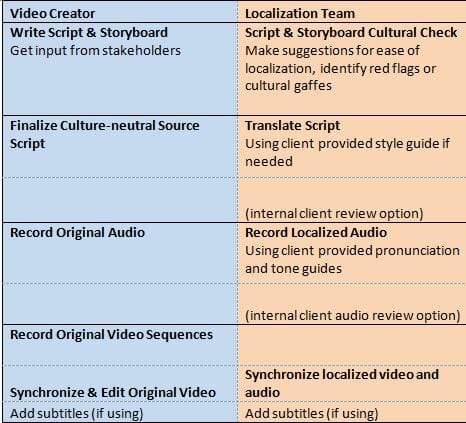— April 25, 2018
Are you considering using video to create user manuals and training materials?
According to the Cisco Visual Networking Index (VNI) Forecast, the shift to video will continue to accelerate. By 2021, video will make up 82% of all IP traffic. Currently, YouTube is the second most popular search engine in the world after Google.
This is especially true for technical communicators. Anton Bolen of TechSmith conducted spot-check surveys at the 2016 Technical Communication World conference and found that 38% of technical communicators were using video for technical communication. A similar survey at LearnTec 2017 found that 83% of respondents considered video “extremely or very important” for training purposes, and 86% planned on using more video content in 2018.
The benefits of video for demonstration and training purposes are obvious. Video shows process in a way that still images and text simply cannot.
If you want to reach an international audience, translating and localizing your videos is a must.
As video trainings become more and more popular, and the demand for globally scalable videos increases, video producers will need to learn how to produce videos that can be easily translated. Culture, visual design, audio, and pacing all need to be taken into account to create a localizable video. If you treat localization as an afterthought, you will run into trouble.
How to create your videos with localization in mind
Always start from a finished, vetted script and storyboard in your source language. Keep in mind that these elements will be invaluable when your localization partner syncs the audio and the visuals.
Culture
- Submit storyboard and script for cultural review BEFORE you start shooting. Certain images, jokes, and concepts might fall flat with the target audience. The goal of a cultural review is to identify and remove or replace offensive or confusing elements to create a “culture-neutral” source video. Unless you are a member of a culture, you can’t always predict what is going to look or sound bad! A good cultural reviewer will be conservative in flagging problems.
Did you know?
- In the Middle East, it’s rude to show the sole of your shoe.
- The number four is bad luck in China.
- Keeping your hand in your pocket is offensive in Korea.
Design
- Limit onscreen text. Use icons instead of words whenever you can.
- Keep the bottom of the screen clear and uncluttered. If you plan to use subtitles, this is where they will appear, and you don’t want to obscure them.
- Try to limit the use of words overall, if you can. Fewer words = easier localization.
Voiceovers or subtitles?
- Subtitles are less expensive than voiceovers because voiceovers require professional recording by voice talents. However, as TTS (text to speech) technology improves, it may be appropriate for some types of videos.
- Voiceover can be the better choice if you want the viewer to focus closely on the screen images. This is especially true of how-to or training videos.
- If you plan to use voiceovers, limit the amount of on-screen speech by characters or talking heads. Lip-synching (overdubbing) and time-consuming. The offscreen narration is easier to localize.
- If you use voiceovers, be prepared to provide guidance on the pronunciation of names and acronyms.
Pacing and Syncing
- Don’t include too many sync points (places where words and visuals need to align perfectly). Sentences in Korean, Japanese, and Chinese are structured differently than English. If you get too fancy with your animation, and you need lots of sync points, it’s going to be more time consuming and difficult to line up the voice-overs (or subtitles) with the on-screen animation.
- If you are using voice-overs, slow down the pacing of the source video. It takes longer to say something in most western European languages than it does in English. Don’t make the voiceover talent “speed read” the narration in order to keep up with the images. Slowing the pace is particularly important for demonstrations of equipment or machines. Your instinct may be to keep the pace lively, to hold the viewer’s attention, but speed WILL throw a wrench into the localization process.
Responsibilities

It’s always best to have a conversation with your localization team before you start work on a video, and to keep the lines of communication open as the process unfolds.
Digital & Social Articles on Business 2 Community
(71)
Report Post









